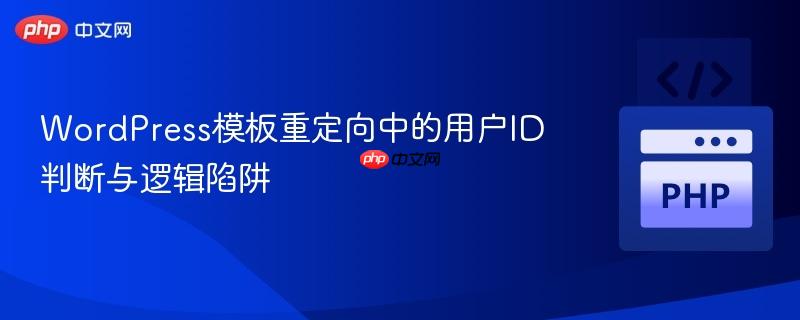
本文深入探讨了在wordpress中使用`template_include`过滤器进行模板重定向时,如何准确判断当前用户id并避免常见的逻辑错误。我们将重点分析`get_current_user_id()`函数的返回值类型、严格比较符`===`的应用,以及条件逻辑设计中的陷阱,通过具体代码示例,指导开发者构建健壮的模板控制逻辑。
在WordPress开发中,我们经常需要根据特定条件(例如用户身份)来动态加载不同的模板文件。template_include过滤器是实现这一目标的关键工具。然而,在实际操作中,对用户ID的判断和条件逻辑的设计往往容易出现混淆,导致预期之外的行为。
get_current_user_id() 是WordPress提供的一个核心函数,用于获取当前登录用户的ID。根据官方文档,此函数返回一个整数(int)类型的用户ID,如果用户未登录,则返回 0。
在PHP中,比较操作符分为两种:
当使用 get_current_user_id() 的返回值进行条件判断时,理解其返回类型至关重要。例如,如果 get_current_user_id() 返回 int(11),那么:
在调试过程中,使用 var_dump(get_current_user_id()) 是一个非常有用的技巧,它可以清晰地展示函数返回值的类型和值,帮助我们避免类型混淆。
template_include 过滤器允许我们在WordPress决定加载哪个模板文件之前进行干预。通过向此过滤器添加一个自定义函数,我们可以检查当前的模板路径,并根据需要返回一个新的模板路径。
locate_template() 函数则用于在主题目录及其父主题目录中查找指定的文件。它返回找到的模板文件的完整路径,如果未找到则返回空字符串。
假设我们有一个自定义文章类型(Custom Post Type)名为 ressource,其对应的模板文件是 single-ressource.php。我们的目标是:只有特定用户(例如ID为11的用户)才能看到 single-ressource.php 的布局,其他所有用户(包括未登录用户)访问 ressource 类型的文章时,都应该看到标准的 single.php 布局。
最初的尝试可能如下:
function template_redirect_initial( $template ) {
// 检查当前模板是否为 single-ressource.php 且当前用户ID为 '11'
if ( $template === locate_template('single-ressource.php') && get_current_user_id() === '11' ) {
return locate_template( array( 'single.php' ) );
}
return $template;
}
add_filter( 'template_include', 'template_redirect_initial', 99 );这段代码的问题在于 get_current_user_id() === '11'。由于 get_current_user_id() 返回的是 int(11),而 '11' 是字符串类型,严格比较 int(11) === '11' 永远为 false。这意味着这个条件分支永远不会被执行,模板重定向不会发生。
如果将 '11' 改为 11,解决了类型比较问题:
function template_redirect_type_fixed( $template ) {
// 检查当前模板是否为 single-ressource.php 且当前用户ID为 11
if ( $template === locate_template('single-ressource.php') && get_current_user_id() === 11 ) {
return locate_template( array( 'single.php' ) );
}
return $template;
}
add_filter( 'template_include', 'template_redirect_type_fixed', 99 );现在,get_current_user_id() === 11 对于ID为11的用户会返回 true。然而,仔细审视我们的目标:我们希望只有ID为11的用户才能看到 single-ressource.php。对于其他用户,我们希望重定向到 single.php。
上述代码的逻辑是:如果用户是ID为11,则重定向到 single.php。这与我们的目标完全相反!这是一个典型的逻辑倒置陷阱。
根据我们的目标——“只有ID为11的用户才能看到 single-ressource.php,其他所有用户都应该看到 single.php”——正确的逻辑应该是:当当前模板是 single-ressource.php 并且当前用户ID不是11时,才进行重定向。
/**
* 根据用户ID控制特定自定义文章类型的模板显示。
*
* 如果当前模板是 'single-ressource.php' 且当前用户ID不是 11,
* 则将模板重定向到 'single.php'。
*
* @param string $template 当前将要加载的模板文件路径。
* @return string 最终要加载的模板文件路径。
*/
function custom_template_redirect( $template ) {
// 检查当前模板是否为 single-ressource.php
// 并且当前用户ID不是 11 (即其他用户或未登录用户)
if ( $template === locate_template('single-ressource.php') && get_current_user_id() !== 11 ) {
// 如果条件满足,则重定向到标准的 single.php 模板
return locate_template( array( 'single.php' ) );
}
// 否则,保持原有的模板(对于用户ID为11的用户,将加载 single-ressource.php)
return $template;
}
add_filter( 'template_include', 'custom_template_redirect', 99 );在这个最终版本中,get_current_user_id() !== 11 准确地表达了“当前用户不是ID为11”的条件。当这个条件为真时,模板被重定向到 single.php。而当用户ID是11时,get_current_user_id() !== 11 返回 false,整个 if 语句不执行,single-ressource.php 模板得以正常加载。
通过对 get_current_user_id() 函数的深入理解、对严格比较符的正确运用,以及对条件逻辑的严谨设计,我们可以有效地在WordPress中实现复杂的模板控制策略,避免常见的编程陷阱,确保网站行为符合预期。
以上就是WordPress模板重定向中的用户ID判断与逻辑陷阱的详细内容,更多请关注php中文网其它相关文章!

每个人都需要一台速度更快、更稳定的 PC。随着时间的推移,垃圾文件、旧注册表数据和不必要的后台进程会占用资源并降低性能。幸运的是,许多工具可以让 Windows 保持平稳运行。

Copyright 2014-2025 https://www.php.cn/ All Rights Reserved | php.cn | 湘ICP备2023035733号